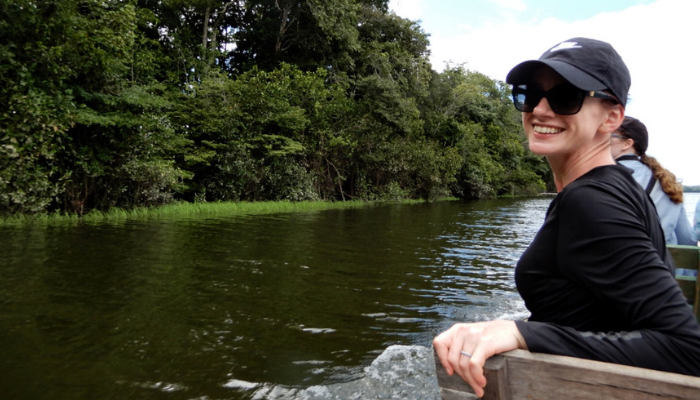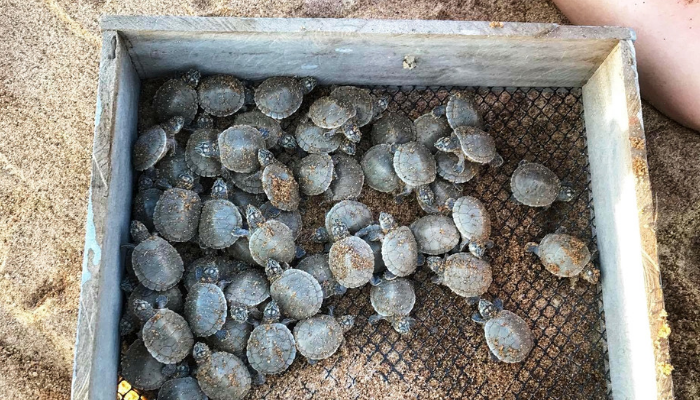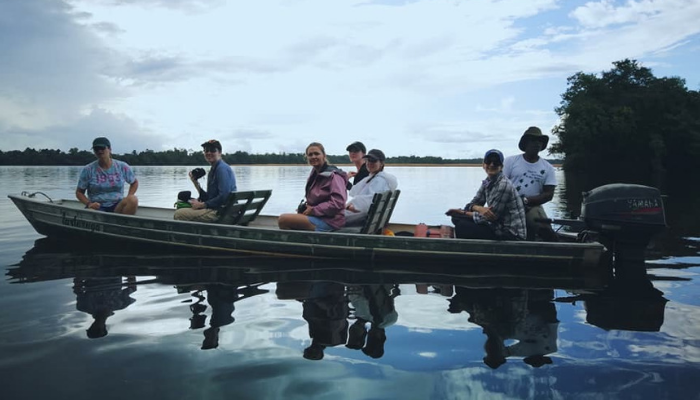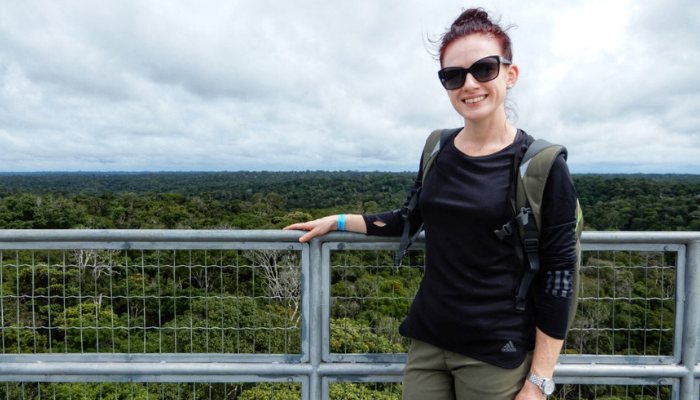Student stories
My two weeks in the Amazon protecting turtles
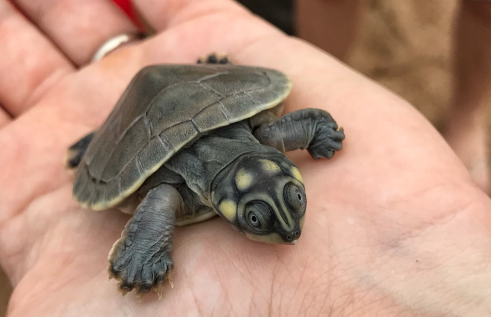
As part of her Bachelor of Environmental Science, CDU student Erica Smith seized the opportunity to cross Brazil off her travel bucket list as she took part in the two-week Brazilian Amazon Field Intensive (BAFI) offered by CDU's College of Engineering, IT and Environment. Erica is currently half-way through her degree and determined to major in Wildlife Conservation.
For the past five years, Erica studied part time so she could fit in her work schedule. Last year, she moved to Darwin from a remote community in East Arnhem Land to transition into full time study at Casuarina Campus and make faster progress toward completing her studies.
Why did you choose this intensive unit in Brazil?
I have been fascinated by the Amazon rainforest from a young age. Growing up, my Dad used to put documentaries on about it regularly. I was also acutely aware that my current work experience had nothing scientific or conservation-based, which would be required if I was to gain meaningful employment in my chosen field.
CDU’s Brazilian Amazon Field Intensive (BAFI) was a means to address both issues: to learn and work in an environment that was of interest to me, whilst gaining valuable field experience that would help me find employment in the future.
Tell us about your field experience in the Amazon rainforest
We initially were based in Manaus for our orientation into the rainforest and the work we would undertake there. We then took a flight and travelled for three days by boat to reach the Porto Trombetas Biological Reserve, in a remote area of the Amazon rainforest.
A biological reserve offers the highest degree of environmental protection in Brazil (higher than what we offer in Australia) and is only accessible to scientists and members of the Indigenous community who lives there
In the reserve, we studied and managed the nests and nesting sites of a species of critically endangered turtle, the Giant Amazon River Turtle (P. Expansa) and three other freshwater turtle species, which are listed as vulnerable. The Giant Amazon River Turtle only nests on sandbanks within this reserve, making the protection of this area particularly important.
Upon arrival at the sandbank, we set up transects, placed temperature loggers in the sand and measured out the nesting area. The river was rising early this year and we realised that the entire sandbank (that all of the species of turtle had nested on) was going to be inundated with water well before the turtles hatched, which would mean a 100% mortality rate for all hatchlings.
In our spare time, we would volunteer to work with the rangers to relocate as many nests as possible, recording nest data as we worked. Many eggs would have stood a strong chance of survival after relocation, ensuring that some of these special turtles would have the chance to begin their lives. All species were due to begin hatching around Christmas Day, so hopefully lots of little turtles crawled down to the water to begin their journeys into the Amazon.
We worked with turtles by day and read papers by night. We visited the Department of Fisheries, scientific institutes, a local school, a University, spoke to environmental teams in the mines and went to community turtle education and hatchling release days. This great adventure was made more worthwhile by the great group of people who came along for the ride. We will laugh about some of the events for years to come...
What were the most challenging parts of this trip?
As a person who has a good night time routine and needs a good six to eight hours of sleep per night to really feel on top of things the following day, I struggled with the lack of sleep from jet lag initially and then disturbed sleep whilst in the field.
We slept in hammocks on a boat for most of the trip (an experience in itself) and as a light sleeper, I was woken up by the engine noise and people moving around each night. The lack of sleep wasn’t a problem when we were out working during the day, but when we came back to the boat and had to read papers at night, understanding and retaining information; and just staying awake was sometimes difficult.
What did you like the most?
Asides from being in an incredibly beautiful corner of the world, where few people have the opportunity to travel and working with the turtles there, there were two stand out experiences for me.
Firstly, it was the amount of wildlife that we saw: different varieties of turtle, caiman, iguanas, frogs, bats, freshwater dolphins, a flock of scarlet macaw, snake, toucans, cheeky monkeys, manatees and many other bird varieties. There was plenty of wildlife both in the Amazon and the institutes that we visited, making for some great photographic opportunities.
Secondly, we took small boats out to visit some other nesting sites and passed through an area that almost seemed like a lake. The water perfectly still, reflecting the clouds like a mirror and the dense, vibrantly green rainforest rose high above us.
It is speculated that this area is where the mother turtles wait for their hatchlings to begin to hatch, before going to greet them and begin their migration of the Amazon. We didn’t see any mother turtles this day. The Rangers believed that fishermen may have been there and scared the turtles away. Despite this, the area was absolutely beautiful and it fit the picture of what I had imagined the Amazon rainforest would look like before I came.
This trip was a whirlwind of learning
The most important things I gained from the field trip was the opportunity to make friends with and network with other students and professionals from our field. Having studied externally for so long and not knowing anyone who worked in environmental science, I felt like I didn’t know anything other than what existed in our textbooks or was recorded on CDU's online learning platform, Learnline.
The Brazilian Amazon Field Intensive (BAFI) gave me the opportunity to meet people at different stages of study, from undergraduate to honours students and listen to their study experiences and how they were planning to go about completing their chosen programs.
I didn’t know a lot about what job opportunities existed in Darwin, what I needed to do to get those jobs, or how I would apply my knowledge in a future workplace. Speaking to industry professionals who took part in the BAFI, helped me to wrap my head around the diverse job opportunities that are out there.
Finally, the BAFI provided me with work experience to add to my resume, which is relevant to the type of work I want to pursue in the future. These elements helped to clear confusions in my mind and will be of great importance to my future study choices and ability to gain employment in wildlife conservation and management.
Studying Environmental Science with CDU gives undergraduate and postgraduate students the unique opportunity of conducting research and gaining practical experiences within some of Australia’s and the world's most spectacular and diverse regions. Find out more about CDU's intensive field units here
Related Articles

The NT inspired Kate to become an environmental scientist
A road trip around Australia sparked a huge career change for Kate. The recent Bachelor of Environmental Science graduate switched gears from real estate to environmental science after falling in love with the uniqueness of the Northern Territory.
Read more about The NT inspired Kate to become an environmental scientist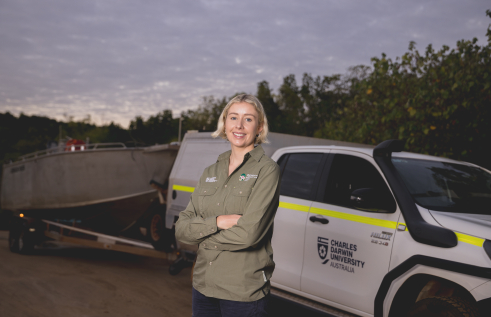
Julia's unexpected road to species-saving research
Julia is researching sharks and rays here in the Top End at Charles Darwin University, a world away from her upbringing in north-western NSW. She's working to ensure some of Australia's most threatened species are around for many generations to come.
Read more about Julia's unexpected road to species-saving research
How can we keep humans and crocodiles safe from each other?
Reports of saltwater crocodile attacks on humans have increased dramatically over the past decade, particularly in Indonesia and Malaysia. One CDU Higher Degree by Research student is currently working on reducing the number of attacks without negatively impacting crocodile populations.
Read more about How can we keep humans and crocodiles safe from each other?
